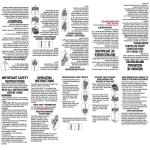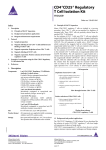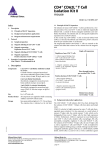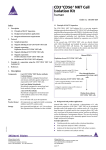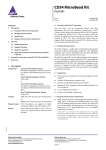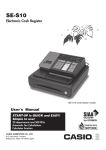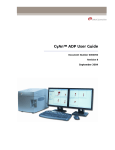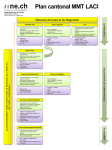Download CD8+ Dendritic Cell Isolation Kit
Transcript
CD8+ Dendritic Cell Isolation Kit mouse Order no. 130-091-169 Contents 1.1 Principle of the MACS® Separation 1. The isolation of CD8+ mouse dendritic cells is performed in a twostep procedure. First, T, B and NK cells are indirectly magnetically labeled with a cocktail of biotin-conjugated antibodies and AntiBiotin MicroBeads. The labeled cells are subsequently depleted by separation over a MACS® Column. In the second step, CD8+ dendritic cells are directly labeled with CD8a (Ly-2) MicroBeads and isolated by positive selection from the pre-enriched dendritic cell fraction. The unlabeled cells run through; this cell fraction is thus depleted of CD8+ cells. After removing the column from the magnetic field, the magnetically retained CD8+ cells can be eluted as the positively selected cell fraction. To increase the purity, the positively selected cell fraction containing the CD8+ cells is separated over a second column. Description 1.1 Principle of the MACS® Separation 1.2 Background information 1.3 Applications 1.4 Reagent and instrument requirements 2. Protocol 2.1 Sample preparation 2.2 Magnetic labeling of T, B and NK cells 2.3 Magnetic separation: Depletion of T, B and NK cells 2.4 Magnetic labeling of CD8+ dendritic cells Single-cell suspension 2.5 Magnetic separation: Positive selection of CD8+ dendritic cells Depletion of T, B, and NK cells 3. Example of a separation using the CD8+ Dendritic Cell Isolation Kit 4. References 1. Indirect magnetic labeling of T, B, and NK cells with Biotin-Antibody Cocktail and Anti-Biotin MicroBeads. 2. Magnetic separation using LD Column, autoMACS or autoMACS Pro (program "Depl025"). 1. Description Components Flow-through fraction: pre-enriched dendritic cells + 1 mL CD8 Dendritic Cell Biotin-Antibody Cocktail, mouse: Cocktail of biotin-conjugated monoclonal anti-mouse antibodies against: CD90.2 (Thy1.2; isotype: rat IgG2b), CD45R (B220; isotype: rat IgG2a), and CD49b (DX5; isotype: rat IgM). 2 mL Anti-Biotin MicroBeads: MicroBeads conjugated to monoclonal antibiotin antibody (clone: Bio3-18E7.2; isotype: mouse IgG1) 2 mL CD8a (Ly-2) MicroBeads: MicroBeads conjugated to monoclonal antimouse CD8a antibody (Ly-2; isotype: rat IgG2a) Capacity For 2×10⁹ total cells, up to 100 separations. Product format All components are supplied in buffer containing stabilizer and 0.05% sodium azide. Storage Store protected from light at 2 − 8 °C. Do not freeze. The expiration date is indicated on the vial label. Positive selection of CD8+ dendritic cells 1. Direct magnetic labeling of CD8+ dendritic cells with CD8a (Ly-2) MicroBeads. 2. Magnetic separation using two MS Columns, autoMACS or autoMACS Pro (program "Posseld2"). Elution from column: CD8+ dendritic cells 1.2 Background information Dendritic cells are a rare, heterogeneous population of hematopoietic cells. This kit was designed for the easy isolation of CD8+ dendritic cells, which constitute one of the three major dendritic cell subpopulations in mouse spleen.1 CD8+ dendritic cells express CD11c, CD205, MHC class II, CD40, CD80 and CD86 and are negative for CD4 and CD11b. In spleen and lymph node, CD8+ dendritic cells are found at moderate levels (23% and 17% of all CD11c+ dendritic cells, respectively) and are located in the T cell areas.2,3 Skin-draining lymph nodes harbor an additional CD8+ dendritic cell subset (CD4-CD8+CD11b+CD205+) which accounts for 33% of all CD11c+ dendritic cells in this organ and is thought to represent the mature form of Langerhans cells.1,4 140-000-882.04 www.miltenyibiotec.com Miltenyi Biotec GmbH Friedrich-Ebert-Str. 68 51429 Bergisch Gladbach, Germany Phone +49 2204 8306-0 Fax +49 2204 85197 Miltenyi Biotec Inc. 12740 Earhart Avenue, Auburn CA 95602, USA Phone 800 FOR MACS, +1 530 888 8871 Fax +1 530 888 8925 page 1/4 Order no. 130-091-169 2. Protocol 1.3 Applications ● antigen-uptake and antigen-processing 2.1 Sample preparation ● T cell activation or T cell tolerance induction ● cross-priming of cytotoxic T cells ● T helper cell polarization by CD8+ dendritic cells. To obtain high numbers of CD8+ dendritic cells with high purities from murine spleen or lymph nodes, single cell suspensions need to be prepared by enzymatic disaggregation with Collagenase D. Protocols which entirely rely on mechanical disruption are not recommended. 1.4 Reagent and instrument requirements ● Buffer: Prepare a solution containing phosphate-buffered saline (PBS), pH 7.2, 0.5% bovine serum albumin (BSA), and 2 mM EDTA by diluting MACS BSA Stock Solution (# 130-091-376) 1:20 with autoMACS™ Rinsing Solution (# 130-091-222). Keep buffer cold (2−8 °C). Degas buffer before use, as air bubbles could block the column. ▲ Note: EDTA can be replaced by other supplements such as anticoagulant citrate dextrose formula-A (ACD-A) or citrate phosphate dextrose (CPD). BSA can be replaced by other proteins such as mouse serum albumin, mouse serum, or fetal bovine serum. Buffers or media containing Ca 2+ or Mg 2+ are not recommended for use. MACS Columns and MACS Separators: Depletion of T, B, and NK cells is performed on an LD Column. The subsequent positive selection of CD8+ dendritic cells is performed on two MS Columns. Depletion and positive selection can also be performed by using the autoMACS or the autoMACS Pro Separator. ● Column Max. number of labeled cells Max. number Separator of total cells Depletion LD 10⁸ 5 ×10⁸ 1. Place isolated spleen in a 6 cm petri-dish with sufficient Collagenase D solution to completely cover the bottom of the dish (5 mL/spleen). 2. Inject mouse spleen with 500 µL of Collagenase D solution per spleen using a 1 mL syringe and a 25G needle, then cut the tissue in smaller pieces by using a pair of scissors. 3. Incubate the spleen pieces in Collagenase D solution for 30 minutes at 37 °C. 4. Pass the whole material, i.e. remaining fragments and Collagenase D-released cells, through a 70 µm cell strainer using a plunger. 5. Collect all cells in a 50 mL tube and wash the cells by adding buffer to obtain a final volume of 15 mL. ▲ Note: Dead cells may bind non-specifically to MACS MicroBeads. In case of high numbers of dead cells, removal of dead cells by density gradient centrifugation or the Dead Cell Removal Kit (# 130-090-101) is recommended. 6. Proceed to magnetic labeling (2.2). MidiMACS, QuadroMACS, VarioMACS, SuperMACS 2.2 Magnetic labeling of T, B, and NK cells Positive selection MS 10⁷ 2 ×10⁸ MiniMACS, OctoMACS, VarioMACS, SuperMACS 4 ×10⁹ autoMACS, autoMACS Pro Depletion or positive selection autoMACS 2×10⁸ ▲ Note: Column adapters are required to insert certain columns into the VarioMACS™ or SuperMACS™ Separators. For details see the respective MACS Separator data sheet. ● ● ● ● ● Collagenase D: 1 mg/mL (Collagenase D >0.15 U/mg, e.g. from Roche Diagnostics, Germany) in 10 mM Hepes-NaOH pH 7.4, 150 mM NaCl, 5 mM KCl, 1 mM MgCl 2, 1.8 mM CaCl2. ▲ Work fast, keep cells cold, and use pre-cooled solutions. This will prevent capping of antibodies on the cell surface and non-specific cell labeling. ▲ Volumes for magnetic labeling given below are for up to 10⁸ total cells. When working with fewer than 10⁸ cells, use the same volumes as indicated. When working with higher cell numbers, scale up all reagent volumes and total volumes accordingly (e.g. for 2×10⁸ total cells, use twice the volume of all indicated reagent volumes and total volumes). ▲ For optimal performance it is important to obtain a single-cell suspension before magnetic separation. Pass cells through 30 µm (Optional) Fluorochrome-conjugated CD8a and CD11c nylon mesh (Pre-Separation Filters, # 130-041-407) to remove cell antibody for flow cytometric analysis, e.g. CD8a-FITC (# 130- clumps which may clog the column. Wet filter with buffer before 091-605), CD8a-PE (# 130-091-603), CD8a-APC (# 1330-091- use. 606), CD11c-FITC (# 130-091-842), CD11c-PE (# 130-091-830), CD11c-APC (# 130-091-844). For more information about 1. Determine cell number. other fluorochrome conjugates see www.miltenyibiotec.com. 2. Centrifuge cell suspension at 300×g for 10 minutes. Aspirate (Optional) Propidium iodide (PI) or 7-AAD for flow cytometric supernatant completely. exclusion of dead cells. 3. Resuspend cell pellet in 200 µL of buffer per 10⁸ total cells. (Optional) Dead Cell Removal Kit (# 130-090-101) for the 4. Add 50 µL of Biotin Antibody Cocktail per 10⁸ total cells. depletion of dead cells. (Optional) Pre-Separation Filters (# 130-041-407) to remove 5. Mix well and incubate for 10 minutes on ice. cell clumps. 140-000-882.04 6. Add 150 µL of buffer and 100 µL of Anti-Biotin MicroBeads per 10⁸ total cells. 7. Mix well and incubate for 15 minutes on ice. www.miltenyibiotec.com Unless otherwise specifically indicated, Miltenyi Biotec products and services are for research use only and not for diagnostic or therapeutic use. page 2/4 Order no. 130-091-169 8. Wash cells by adding 5−10 mL of buffer per 10⁸ cells and centrifuge at 300×g for 10 minutes at 4 °C. Aspirate supernatant completely. 9. Resuspend cell pellet in buffer: Depletion with LD Column: Depletion with autoMACS: 500 µL for up to 1.25×108 cells 500 µL for up to 1×108 cells ▲ Note: For larger cell numbers, scale up buffer volume accordingly. 10. Proceed to magnetic separation (2.3). 2.3 Magnetic separation: Depletion of T, B, and NK cells Depletion with LD Columns 2.4 Magnetic labeling of CD8+ dendritic cells ▲ Volumes for magnetic labeling given below are for an initial starting cell number of up to 10⁸ total cells. When working with fewer than 10⁸ cells, use the same volumes as indicated. When working with higher cell numbers, scale up all reagent volumes and total volumes accordingly. 1. Centrifuge cell suspension at 300×g for 10 minutes. Aspirate supernatant completely. 1. Place LD Column in the magnetic field of a suitable MACS Separator. For details see LD Column data sheet. 2. Resuspend cell pellet in 400 µL of buffer per 10⁸ total cells. 3. Add 100 µL of CD8a (Ly-2) MicroBeads per 10⁸ total cells. 2. Prepare column by rinsing with 2 mL of buffer. 4. 3. Apply cell suspension onto the column. 4. Collect unlabeled cells that pass through and wash column with 2×1 mL of buffer. Collect total effluent; this is the unlabeled cell fraction. Perform washing steps by adding buffer two times. Only add new buffer when the column reservoir is empty. 5. Mix well and incubate for 30 minutes on ice. ▲ Note: Mix cells once during the incubation time. 5. Wash cells by adding 5−10 mL of buffer per 10⁸ cells and centrifuge at 300×g for 10 minutes at 2–8 °C. Aspirate supernatant completely. 6. Resuspend up to 108 cells in 500 µL of buffer. 7. Proceed to magnetic separation (2.5). + Proceed to 2.4 for the isolation of CD8 dendritic cells. 2.5 Magnetic separation: Positive selection of CD8+ dendritic cells Depletion with the autoMACS™ Separator or the autoMACS™ Pro Separator ▲ Refer to the respective user manual for instructions on how to use the autoMACS™ Separator or the autoMACS Pro Separator. Positive selection with MS Columns ▲ Buffers used for operating the autoMACS Separator or the autoMACS Pro Separator should have a temperature of ≥ 10 °C. ▲ To achieve highest purities, always perform two cosecutive column runs. ▲ Program choice depends on the isolation strategy, the strength of magnetic labeling, and the frequency of magnetically labeled cells. For details refer to the section describing the cell separation programs in the respective user manual. Magnetic separation with the autoMACS™ Separator 1. Prepare and prime the instrument. 2. Apply tube containing the sample and provide tubes for collecting the labeled and unlabeled cell fractions. Place sample tube at the uptake port and the fraction collection tubes at port neg1. 3. For a standard separation choose the following program: Depletion: “Depl025” Collect negative fraction from outlet port neg1. Magnetic separation with the autoMACS™ Pro Separator 1. Prepare and prime the instrument. 2. Apply tube containing the sample and provide tubes for collecting the labeled and unlabeled cell fractions. Place sample tube in row A of the tube rack and the fraction collection tubes in rows B and C. 3. For a standard separation choose the following program: 1. Place column in the magnetic field of a suitable MACS Separator. For details see the respective MACS Column data sheet. 2. Prepare column by rinsing with 500 µL of buffer: 3. Apply cell suspension onto the column. 4. Collect unlabeled cells that pass through and wash column with 3×500 µL of buffer. Collect total effluent; this is the unlabeled cell fraction. Perform washing steps by adding buffer three times. Only add new buffer when the column reservoir is empty. 5. Remove column from the separator and place it on a suitable collection tube. ▲ Note: To perform a second column run, you may elute the cells directly from the first onto the second, equilibrated column instead of a collection tube. 6. Pipette 1 mL of buffer onto the column. Immediately flush out the magnetically labeled cells by firmly pushing the plunger into the column. 7. To increase the purity of CD8+ cells, the eluted fraction must be enriched over a second MS Column. Repeat the magnetic separation procedure as described in steps 1 to 6 by using a new column. xxx-xxx-xxx.0x Depletion: “Depl025” Collect negative fraction in row B of the tube rack. www.miltenyibiotec.com Unless otherwise specifically indicated, Miltenyi Biotec products and services are for research use only and not for diagnostic or therapeutic use. page 3/4 Order no. 130-091-169 Positive selection with the autoMACS™ Separator or the autoMACS™ Pro Separator Pre-enriched CD11c+ dendritic cells ▲ Refer to the respective user manual for instructions on how to use the autoMACS™ Separator or the autoMACS Pro Separator. CD11c-FITC ▲ Buffers used for operating the autoMACS Separator or the autoMACS Pro Separator should have a temperature of ≥ 10 °C. ▲ Program choice depends on the isolation strategy, the strength of magnetic labeling, and the frequency of magnetically labeled cells. For details refer to the section describing the cell separation programs in the respective user manual. CD8-PE Magnetic separation with the autoMACS™ Separator 1. Prepare and prime the instrument. Isolated CD8+CD11c+ dendritic cells 2. Apply tube containing the sample and provide tubes for collecting the labeled and unlabeled cell fractions. Place sample tube at the uptake port and the fraction collection tubes at port neg1 and port pos2. CD11c-FITC 3. For a standard separation choose the following program: Positive selection: “Posseld2” Collect positive fraction from outlet port pos2. Magnetic separation with the autoMACS™ Pro Separator 1. Prepare and prime the instrument. 2. Apply tube containing the sample and provide tubes for collecting the labeled and unlabeled cell fractions. Place sample tube in row A of the tube rack and the fraction collection tubes in rows B and C. 3. For a standard separation choose the following program: Positive selection: “Posseld2” Collect positive fraction in row C of the tube rack. 3. Example of a separation using the CD8+ Dendritic Cell Isolation Kit + CD8 dendritic cells were isolated from a mouse spleen using the CD8+ Dendritic Cell Isolation Kit, an LD and two MS Columns, a MidiMACS™ and a MiniMACS™ Separator. Cells are fluorescently stained with CD11c-FITC (# 130-091-842) and CD8a-PE (# 130-091603). Cell debris and dead cells are excluded from the analysis based on scatter signals and PI fluorescence. CD8-PE 4. References 1. Shortman, K; and Liu, YJ. (2002) Mouse and human dendritic cell subtypes. Nat. Rev. Immunol. 2(3): 151-161. 2. Anjuere, F. et al. (1999) Definition of dendritic cell subpopulations present in the spleen, Peyer's patches, lymph nodes, and skin of the mouse. Blood 93(2): 590-598. 3. Vremec, D. et al. (2000) CD4 and CD8 expression by dendritic cell subtypes in mouse thymus and spleen. J. Immunol. 164: 2978-2986. 4. Henri, S. et al. (2001) The dendritic cell populations of mouse lymph nodes. J.Immunol. 167: 741-748. All protocols and data sheets are available at www.miltenyibiotec.com. Warnings Reagents contain sodium azide. Under acidic conditions sodium azide yields hydrazoic acid, which is extremely toxic. Azide compounds should be diluted with running water before discarding. These precautions are recommended to avoid deposits in plumbing where explosive conditions may develop. Before separation Warranty CD11c-FITC The products sold hereunder are warranted only to be free from defects in workmanship and material at the time of delivery to the customer. Miltenyi Biotec GmbH makes no warranty or representation, either expressed or implied, with respect to the fitness of a product for a particular purpose. There are no warranties, expressed or implied, which extend beyond the technical specifications of the products. Miltenyi Biotec GmbH’s liability is limited to either replacement of the products or refund of the purchase price. Miltenyi Biotec GmbH is not liable for any property damage, personal injury or economic loss caused by the product. CD8-PE MACS is a registered trademark and autoMACS, MidiMACS, MiniMACS, OctoMACS, QuadroMACS, SuperMACS, and VarioMACS are trademarks of Miltenyi Biotec GmbH. 140-000-882.04 © 2008 Miltenyi Biotec GmbH. www.miltenyibiotec.com Unless otherwise specifically indicated, Miltenyi Biotec products and services are for research use only and not for diagnostic or therapeutic use. page 4/4




